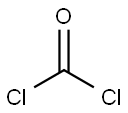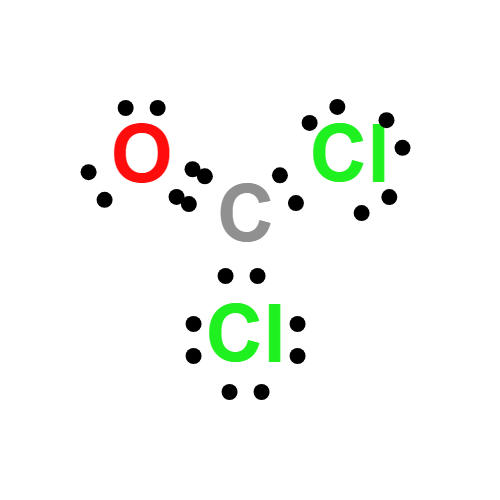
PHOSGENE
- Product NamePHOSGENE
- CAS75-44-5
- CBNumberCB7123616
-
MFCCl2O
Lewis structure
- MW98.92
- EINECS200-870-3
- MDL NumberMFCD00036119
- MOL File75-44-5.mol
Chemical Properties
| Melting point | -118° |
| Boiling point | bp760 8.2° |
| Density | 0.94 g/mL at 20 °C |
| vapor pressure | 1180 mm Hg ( 20 °C) |
| refractive index | 1.3561 |
| Flash point | 4 °C |
| storage temp. | 2-8°C |
| solubility | slightly soluble in H2O; soluble in benzene, toluene |
| form | colorless gas |
| color | colorless |
| Odor | Sweet, hay-like odor at lower levels, pungent at higher levels; detectable at 0.1 to 5.7 ppm |
| Water Solubility | slightly soluble and hydrolyzed in H2O; soluble benzene, toluene [HAW93] |
| Merck | 13,7421 |
| Exposure limits | TLV-TWA 0.1 ppm (~0.4 mg/m3 ) (ACGIH, MSHA, OSHA, and NIOSH); 0.2 ppm (15- minute ceiling) (NIOSH); IDLH 2 ppm (NIOSH). |
| Dielectric constant | 4.7(0℃) |
| Indirect Additives used in Food Contact Substances | PHOSGENE |
| CAS DataBase Reference | 75-44-5(CAS DataBase Reference) |
| EWG's Food Scores | 4 |
Safety
| Symbol(GHS) |
  
|
|||||||||
| Signal word | Danger | |||||||||
| Hazard statements | H314-H330 | |||||||||
| Precautionary statements | P260-P264-P280-P301+P330+P331-P303+P361+P353-P363-P304+P340-P310-P321-P305+P351+P338-P405-P501-P260-P271-P284-P304+P340-P310-P320-P403+P233-P405-P501 | |||||||||
| Hazard Codes | T+,F | |||||||||
| Risk Statements | 26-34-67-65-63-48/20-11-39/26 | |||||||||
| Safety Statements | 9-26-36/37/39-45-62-28-16 | |||||||||
| RIDADR | UN 3384 6.1/PG 1 | |||||||||
| OEB | C | |||||||||
| OEL | TWA: 0.1 ppm (0.4 mg/m3), Ceiling: 0.2 ppm (0.8 mg/m3) [15-minute] | |||||||||
| WGK Germany | 2 | |||||||||
| RTECS | SY5600000 | |||||||||
| F | 3-21 | |||||||||
| DOT Classification | 2.3, Hazard Zone A (Gas poisonous by inhalation) | |||||||||
| HazardClass | 2.3 | |||||||||
| HS Code | 28121030 | |||||||||
| Hazardous Substances Data | 75-44-5(Hazardous Substances Data) | |||||||||
| Toxicity | LC50 inhal (rat) 341 ppm (1364 mg/m3; 30 min) PEL (OSHA) 0.1 ppm (0.4 mg/m3) TLV-TWA (ACGIH) 0.1 ppm (0.4 mg/m3) | |||||||||
| IDLA | 2 ppm | |||||||||
| NFPA 704: |
|
